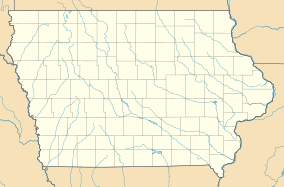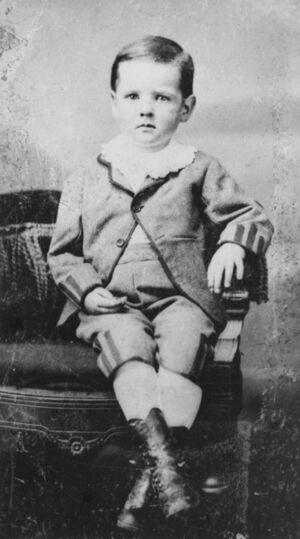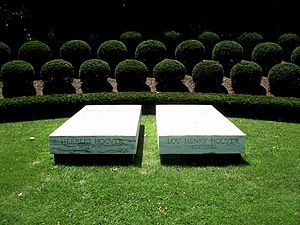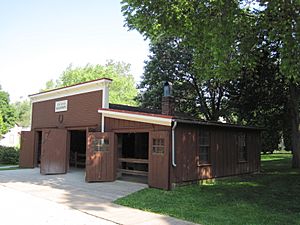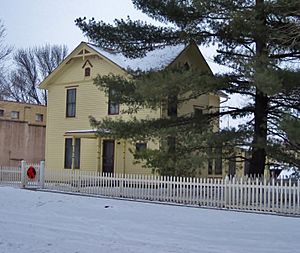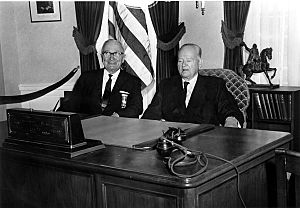Herbert Hoover National Historic Site facts for kids
Quick facts for kids Herbert Hoover National Historic Site |
|
|---|---|

Herbert Hoover Birthplace Cottage
|
|
| Location | West Branch, Iowa, US |
| Nearest city | Iowa City, Iowa |
| Area | 186.8 acres (75.6 ha) |
| Established | August 12, 1965 |
| Visitors | 152,214 (in 2005) |
| Governing body | National Park Service |
| Website | Herbert Hoover National Historic Site |
|
Herbert Hoover National Historic Site
|
|
| NRHP reference No. | 66000110 (original) 13000594 (increase) |
| Significant dates | |
| Added to NRHP | October 15, 1966 |
| Boundary increase | August 14, 2013 |
| Designated NHLD | June 23, 1965 |
The Herbert Hoover National Historic Site is a special place in West Branch, Iowa, USA. It's part of the National Park System. The National Park Service takes care of the buildings and land here. They do this to remember the life of Herbert Hoover, who was the 31st president of the United States.
This park was created in 1965. It was recognized as a National Historic Landmark just before that. Today, the site covers about 187 acres.
Herbert Hoover lived his first eleven years in West Branch. He was born in a small cottage in 1874. His father was a blacksmith in the town. Later, his family moved to a bigger house nearby. Sadly, Hoover became an orphan when he was young. He then left West Branch to live with relatives in Oregon. Hoover grew up to be a very successful mining engineer, a helper to people in need, and eventually, the President.
After Hoover became famous, his birthplace cottage became a popular spot for visitors. His family bought the cottage in the 1930s. They wanted to create a park that showed what Hoover's childhood was like. Today, you can see a blacksmith shop like his father's. There's also the first schoolhouse in West Branch and the Quaker meetinghouse where his family went to church. The Herbert Hoover Presidential Library and Museum opened in the 1960s. It holds Hoover's presidential papers and other important items. Herbert Hoover and his wife, Lou Henry Hoover, are buried here. Their gravesite has a special monument. After Hoover passed away, a beautiful 81-acre tallgrass prairie was created.
Contents
What is the History of Herbert Hoover's Childhood Home?
Hoover's Early Life in West Branch
Herbert Clark Hoover spent his first eleven years in West Branch, Iowa. It was a small farming town with about 500 people. His birthplace cottage was built in 1871. It was a small house, only 14 by 20 feet, with two rooms. His parents, Jesse and Hulda Hoover, were Quakers. Jesse was a blacksmith and opened his shop soon after they moved there.
Herbert, who was called "Bert" or "Bertie" as a child, was born on August 10, 1874. He was the second child. His father's blacksmith business did very well. In 1878, Jesse Hoover sold his shop. He then opened a farm equipment store. In March 1879, the family moved to a two-story house called the "House of the Maples." Young Herbert might have gone to school in an old schoolhouse from 1853. He also attended Quaker church services nearby.
The family's good times ended sadly. Jesse died from rheumatic fever on December 13, 1880. Hulda worked hard to support her family by sewing and taking in boarders. But she also died from typhoid fever on February 24, 1884. Herbert was only nine years old and now an orphan. He went to live with his uncle Allan Hoover on a farm nearby. Two years later, he moved to Newberg, Oregon, to live with another uncle.
Hoover's Career and Presidency
Herbert Hoover became a very successful mining engineer. He earned a lot of money working in places like Australia and China. He married Lou Henry in 1899. During World War I, Hoover was very concerned about people in Europe who didn't have enough food. He helped lead a group called the Commission for Relief in Belgium. This group fed the country of Belgium during the war. When the United States joined the war, Hoover became the head of the United States Food Administration. People in America praised him for his great work.
In 1920, he helped Warren G. Harding become president. Harding then made Hoover the United States Secretary of Commerce. In 1928, Hoover was chosen by the Republican Party to run for president. He won by a lot against Al Smith. However, his time as president was difficult because of the Great Depression. This was a time when many people lost their jobs and money. Even though he tried to fix the economy, Hoover lost the next election in 1932 to Franklin D. Roosevelt. During World War II, Hoover again helped provide food to countries affected by the war.
Where is Herbert Hoover Buried?
Herbert Hoover passed away in 1964. He had the longest retirement of any president up to that time. Hoover felt that his years in West Branch were very important in shaping who he became. He asked to be buried there with his wife, who had died twenty years earlier. His son, Allan Hoover, chose the spot. It was prepared before Herbert Hoover's death. About 100,000 people watched his funeral procession. William Wagner designed the memorial with help from Hoover's family. From the monument, you can see the small cottage where Hoover was born.
How Did the Historic Site Develop?
The birthplace cottage was bought by R. Portland and Jennie Scellers in 1889. They moved it and built a bigger house connected to it. In 1928, when Hoover was nominated for president, many tourists came to West Branch. Jennie Scellers, who was a widow, opened the cottage for tours. She charged ten cents and had over 17,000 visitors in the first year! She didn't want to sell the house to the Hoover family. But after she died in 1934, Hoover's son Allan bought it. He tore down the bigger house and put the cottage back in its original spot.
Hoover and his family believed that showing visitors his early home would inspire them. After Allan bought the cottage in 1935, they started to develop the area. By 1938, a group called the Hoover Birthplace Committee had restored the cottage. Lou Henry Hoover led this group until she died in 1944. She helped move a statue called Isis and bought land around the birthplace. She also had a wall built along Hoover Creek and a path to connect the cottage to the Isis statue. She planted trees, bushes, and flowers. Allan Hoover took over the project after his mother passed away.
The birthplace park held the first "Hoover Day" celebration for Hoover's 74th birthday in 1948. Many people came to celebrate. This inspired Allan Hoover to make the site even better for his father's 80th birthday in 1954. The Herbert Hoover Birthplace Park was officially opened on June 30, 1952. Later, a picnic shelter was built. In 1954, the Boy Scouts of America also built a picnic shelter and put up a bronze plaque for the former president. In 1957, the Hoover family decided to rebuild Jesse Hoover's blacksmith shop. They used wood from an old barn. This blacksmith shop is still working today, making iron items.
In the late 1950s, the park grew a lot. This was because Interstate 80 was planned to pass nearby. Buying more land helped protect the historical area. In 1964, a 1905 house was moved to the park. It became the office for the Director of the Presidential Library. Around the same time, the Quaker Meetinghouse was moved to the site. The Hoovers didn't like this idea at first because the church was originally far away. But they agreed when they learned it might be torn down. It was the last building moved to the site before Hoover died.
What Can You See at the Herbert Hoover National Historic Site?

The Herbert Hoover Birthplace was named a National Historic Landmark in 1965. The National Historic Site was officially created on August 12, 1965. When the National Register of Historic Places was started a year later, the site was automatically added.
The National Historic Site shows several buildings that were in West Branch when Hoover was a child. The 1853 schoolhouse was moved close to its original spot. The Friends Meetinghouse, where Hoover went to church, is also there. Jesse Hoover's blacksmith shop has been rebuilt. You can visit these four buildings for free. You can also visit the gravesite, which looks out over the birthplace cottage. Near the gravesite is a tallgrass prairie. It looks like the landscape that early settlers in West Branch would have seen. This prairie became a National Recreation Trail in 1981.
A large statue of the Egyptian goddess Isis is also at the site. The people of Belgium gave this statue to Hoover. They were thankful for his help in providing food to their country during the war. A Belgian artist named Auguste Puttemans sculpted it. The statue used to be at Hoover's home in Palo Alto, California. The Hoovers brought it to West Branch in 1939. It is placed so it seems to be "thinking about the house" where Hoover was born.
The site also includes old houses on Downey and Poplar Streets. These houses belonged to important people in West Branch. They are not open to the public. Some are used for park offices or storage. In 2020, the park started a project to help with flooding from Hoover Creek. This project will make the creek wider and build a new water storage area in the prairie.
Historic Houses on Downey Street
Laban Miles was Herbert Hoover's uncle by marriage. The Miles and Hoover families were good friends, and Herbert played with the Miles children. Laban Miles later worked for President Rutherford B. Hayes. Herbert briefly lived with the Miles family in 1882. The Amanda Garvin House on Downey Street is a nice example of Gothic Revival architecture. The Charles E. Smith House was moved to the site in 1969. It shows Queen Anne architecture.
Hannah Varney built her house in 1899. Her daughters lived there until 1915. This house was moved to its current spot in 1967. The P. T. Smith House was one of the few houses Hoover remembered clearly when he visited West Branch later. The Hoover and Smith children often played together, especially sledding on Cook's Hill.
Historic Houses on Poplar Street
There are four houses kept on Poplar Street. The Wright family built a house there in 1873. Billy Wright, like Jesse Hoover, was a blacksmith. E. S. Hayhurst built a house in 1872. John Wetherell and his wife built a house in 1872 and sold it to Dr. John Staples. David Mackey, a carpenter, built his own house in 1869. He died shortly after, leaving the house to his family. The Mackey and Wright Houses have changed the least since they were built.
What is the Herbert Hoover Presidential Library and Museum?
In 1939, President Franklin D. Roosevelt started the first Presidential library. It was a place to keep his presidential papers. He gave land and items to the government and built the library with private money. The National Archives and Records Administration was put in charge of it. President Truman also decided to build a similar library in 1945. Because of this, the United States Congress passed a law in 1955. This law created a system for all Presidential libraries.
Hoover first planned to give his papers to his college, Stanford University. He also wanted a small museum in West Branch. But his relationship with Stanford changed in the 1950s. So, Hoover decided to build a presidential library and museum in West Branch instead. The Herbert Hoover Presidential Library and Museum was the fourth one of its kind. It opened on Hoover's 88th birthday, August 10, 1962. It is one of three presidential libraries that include the president's birthplace or childhood home and gravesite.
President Harry Truman and Hoover gave speeches at the opening ceremony. President Ronald Reagan rededicated the library and museum in 1992 after it was made much larger. The museum is the only part of the National Historic Site that charges an entrance fee.
See Also
- List of residences of presidents of the United States
- List of National Historic Landmarks in Iowa
- List of areas in the United States National Park System
- West Branch Commercial Historic District, a shopping area nearby
- Hoover–Minthorn House, Hoover's childhood home in Oregon
- Lou Henry and Herbert Hoover House, their home in Palo Alto, California
- Rapidan Camp, Hoover's quiet getaway in Shenandoah National Park, Virginia
- Hoover Dam, a famous dam named after Hoover


